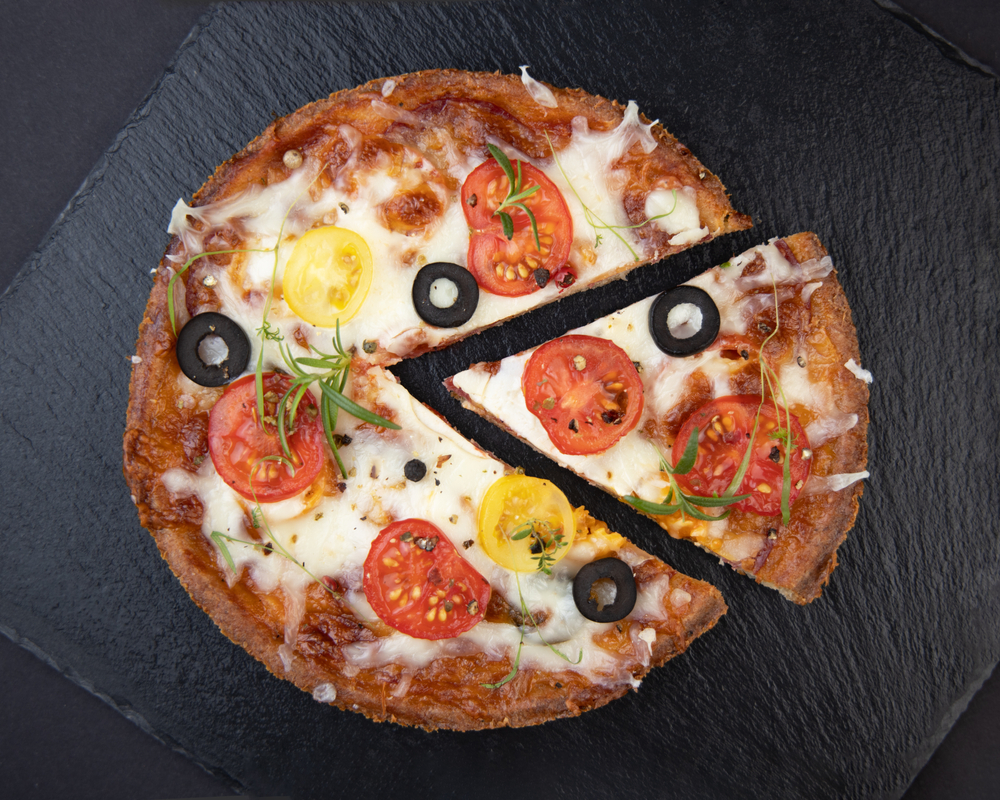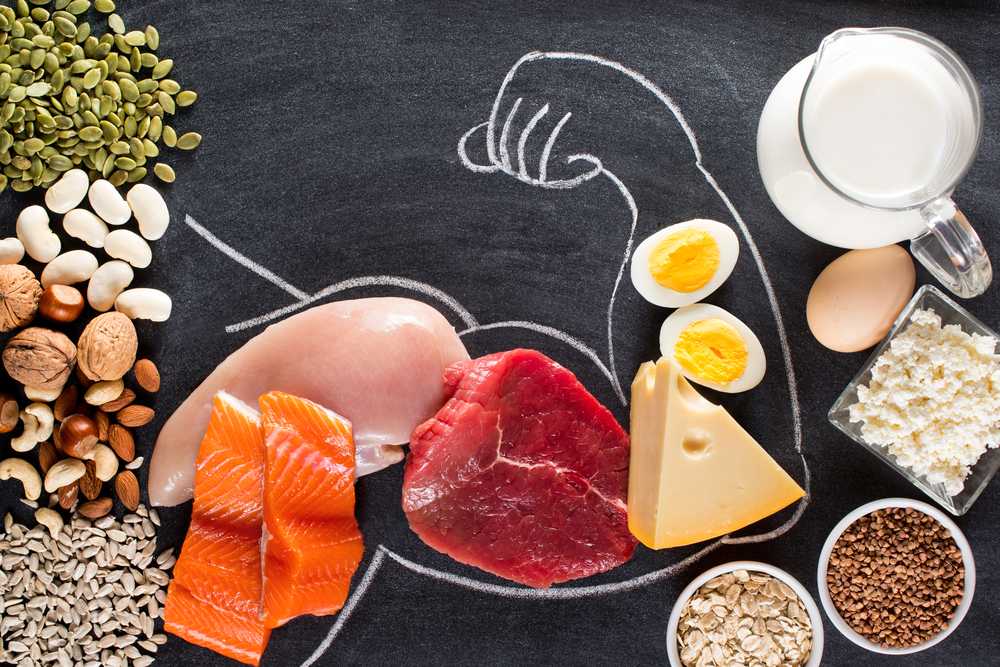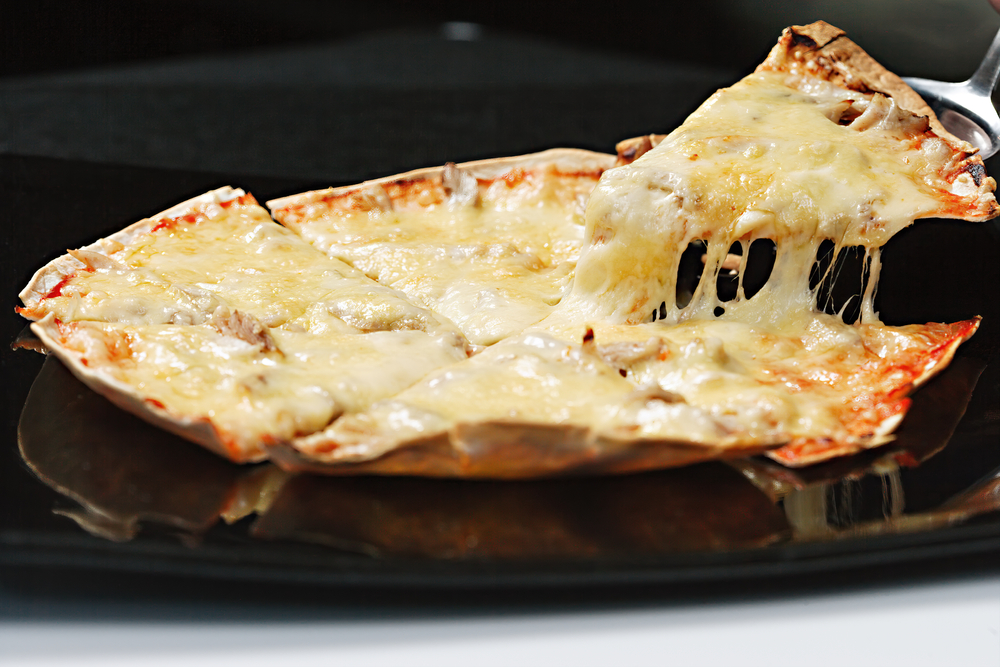Pizza is among the most widely consumed foods in the world and for good reason. It’s filling, tasty, and simple to share with loved ones.

However, a lot of people are worried about the pizza’s protein content and overall nutritional value. We’ll look at the protein composition of pizza in this post, including how much is in it and which toppings are the best sources of protein.
Pizza’s protein content might vary greatly. The protein value might vary greatly depending on the type of crust, cheese, and toppings you select.
For instance, a cheese pizza slice normally has 12 grams of protein, whereas a pepperoni pizza slice has 14 grams.
However, you can easily increase the protein level to 20 grams or more per slice if you choose a vegetarian pizza that is loaded with vegetables and a protein-rich cheese like feta or mozzarella.
Pizza is frequently high in fat and carbohydrates, which can be an issue if you’re attempting to maintain a balanced diet, making it difficult to acquire enough protein from it.
Pizza can be a protein-rich dinner that satisfies cravings without compromising your dietary objectives, though, if you pick the correct toppings and keep an eye on your portion sizes.
We’ll discuss some of the top protein sources for pizza and how to include them in your favorite pie in the section that follows.
The Role of Protein in Pizza
When it comes to pizza, most people tend to focus on the carb-heavy crust and the ooey-gooey cheese. However, protein is also an important component of this beloved dish. In this section, we will explore the role of protein in pizza.

Protein Content in Pizza
The protein content in pizza can vary depending on the type of crust, sauce, and toppings used. However, most slices of pizza contain around 12 grams of protein.
This protein mainly comes from cheese and toppings such as pepperoni, sausage, and chicken.
Benefits of Protein in Pizza
Protein plays an important role in our bodies. It helps to build and repair tissues, as well as produce enzymes and hormones.
When it comes to pizza, the protein content can help to make the dish more satisfying and filling. This can be especially beneficial for those trying to manage their weight or build muscle.
Choosing Protein-Packed Toppings
If you’re looking to increase the protein content of your pizza, there are a few toppings you can add that are particularly high in protein. These include:
- Chicken
- Beef
- Turkey
- Ham
- Sausage
- Pepperoni
- Bacon
- Anchovies
- Tofu
Adding these toppings to your pizza can help to increase the overall protein content of the dish.
Conclusion
Protein may not be the first thing that comes to mind when you think of pizza, but it plays an important role in this beloved dish.
By choosing protein-packed toppings and being mindful of the protein content in your pizza, you can enjoy a delicious and satisfying meal while still meeting your nutritional needs.
Nutritional Information of Pizza
When it comes to pizza, it’s important to know the nutritional information so you can make informed decisions about what you eat.
Here’s a breakdown of the nutritional information for pizza, including calories, carbs, sodium, fats, and cholesterol.

Calories
The number of calories in a slice of pizza can vary depending on the size of the slice, the type of crust, and the toppings. On average, a slice of cheese pizza contains around 240 calories.
However, a slice of pizza from a chain like Pizza Hut can contain up to 300 calories for 1/5th of a medium pizza.
It’s important to keep in mind that if you add toppings like sausage or extra cheese, the calorie count will increase.
Carbs
Carbohydrates are a major component of pizza, as they make up the bulk of the crust. A slice of cheese pizza typically contains around 30 grams of carbs.
However, the amount of carbs can vary depending on the type of crust and the toppings. For example, a thin-crust pizza will generally have fewer carbs than a deep-dish pizza.
Sodium
Pizza can be high in sodium, which can be a concern for people with high blood pressure or other health issues.
A slice of cheese pizza can contain up to 600 milligrams of sodium, which is about 25% of the recommended daily intake. If you add toppings like pepperoni or sausage, the sodium content will be even higher.
Fats
Pizza can also be high in fat, especially if you choose toppings like sausage or extra cheese. A slice of cheese pizza typically contains around 10 grams of fat.
However, the amount of fat can vary depending on the toppings and the type of crust. For example, a deep-dish pizza will generally have more fat than a thin-crust pizza.
Cholesterol
Pizza can also be high in cholesterol, especially if you choose toppings like sausage or bacon. A slice of cheese pizza typically contains around 20 milligrams of cholesterol. However, if you add toppings like sausage or bacon, the cholesterol content will be higher.
Pizza can be a tasty treat, but it’s important to be aware of the nutritional information. By choosing healthier toppings and being mindful of portion sizes, you can enjoy pizza as part of a balanced diet.
Cheese and Meat Toppings
When it comes to pizza toppings, cheese and meat are two of the most popular choices. Let’s take a closer look at mozzarella cheese, meat, and toppings commonly found on pizza.

Mozzarella Cheese
Mozzarella cheese is a staple on most pizzas. It’s a soft, mild cheese that melts well and is perfect for pizza. It’s also a good source of protein, with one ounce containing about 6 grams of protein.
However, keep in mind that mozzarella cheese is also high in calories and saturated fat, so it’s important to enjoy it in moderation.
Meat
Meat toppings like pepperoni, grilled chicken, and meatballs are also popular choices. These toppings can add a significant amount of protein to your pizza.
For example, a slice of pepperoni pizza can contain around 14 grams of protein. However, it’s important to choose leaner meats like grilled chicken or turkey instead of fatty meats like sausage or bacon. These leaner meats will provide protein without adding too much-saturated fat to your meal.
Toppings
In addition to cheese and meat, there are a variety of other toppings you can add to your pizza to increase its protein content. Vegetables like spinach, broccoli, and mushrooms are all great sources of protein.
You can also add beans or tofu for a vegetarian option. Just be sure to watch your portion sizes and choose toppings that are lower in calories and saturated fat.
Here’s a breakdown of the protein content in some common pizza toppings:
| Topping | Protein per 1 oz |
|---|---|
| Mozzarella | 6g |
| Pepperoni | 7g |
| Grilled chicken | 8g |
| Meatballs | 6g |
| Spinach | 1g |
| Broccoli | 1g |
| Mushrooms | 1g |
| Beans | 4g |
| Tofu | 3g |
Cheese and meat toppings are great sources of protein for your pizza. Just be sure to choose leaner meats and watch your portion sizes.
Adding vegetables, beans, or tofu can also increase the protein content of your pizza while keeping it healthy and delicious.
Vegetarian and Vegan Options
When it comes to protein in pizza, vegetarian and vegan options are a great way to get your protein fix without any meat. Here are some options:

Tofu
Tofu is a great source of protein and can be used as a topping on pizza. It has a mild flavor and can be marinated to add more flavor. It can also be crumbled and used as a substitute for cheese. Here are some ways to incorporate tofu into your pizza:
- Crumble tofu and sprinkle it over your pizza before baking
- Marinate tofu in your favorite sauce and use it as a topping
- Use tofu as a substitute for cheese on your pizza
Tempeh
Tempeh is another great source of protein and can be used as a meat substitute on pizza. It has a nutty flavor and can be sliced thin and used as a topping. Here are some ways to incorporate tempeh into your pizza:
- Slice tempeh thin and use it as a topping on your pizza
- Marinate tempeh in your favorite sauce before using it as a topping
- Use tempeh as a substitute for meat on your pizza
Vegetables
Vegetables are a great way to add protein to your pizza. Some vegetables that are high in protein include spinach, broccoli, and mushrooms. Here are some ways to incorporate vegetables into your pizza:
- Add spinach, broccoli, or mushrooms as toppings on your pizza
- Use a vegetable-based sauce, such as pesto, as a base for your pizza
- Use a variety of vegetables to create a colorful and flavorful pizza
There are many vegetarian and vegan options for adding protein to your pizza. Tofu, tempeh, and vegetables are all great options that can be used in a variety of ways.
By incorporating these options into your pizza, you can enjoy a delicious and protein-packed meal.
Alternative Pizza Crusts
When we think of pizza, the first thing that comes to our mind is the traditional pizza crust made from refined flour.

However, with the increasing awareness of health and fitness, people are now looking for alternative crust options. In this section, we will discuss some alternative pizza crusts that are not only healthy but also delicious.
Self-Rising Flour
Self-rising flour is a type of flour that contains baking powder and salt. It is a popular alternative to traditional pizza crusts because it is easy to work with and requires no yeast. Self-rising flour crusts are also lighter and fluffier than traditional crusts.
To make a self-rising flour crust, mix self-rising flour, salt, and water in a bowl. Knead the dough for a few minutes until it becomes smooth.
Roll the dough out into a thin circle and add your favorite toppings. Bake the pizza in the oven for 10-15 minutes until the crust is golden brown.
Greek Yogurt
Greek yogurt is another healthy alternative to traditional pizza crusts. It is high in protein and low in carbs, making it an excellent choice for people who are watching their weight.
Greek yogurt crusts are also easy to make and have a tangy flavor that pairs well with pizza toppings.
To make a Greek yogurt crust, mix Greek yogurt, flour, and salt in a bowl. Knead the dough until it becomes smooth.
Roll the dough out into a thin circle and add your favorite toppings. Bake the pizza in the oven for 10-15 minutes until the crust is golden brown.
Pasta
Pasta crusts are a unique and delicious alternative to traditional pizza crusts. They are made from cooked pasta and eggs and have a crispy texture that pairs well with pizza toppings. Pasta crusts are also easy to make and are a great way to use up leftover pasta.
To make a pasta crust, mix cooked pasta, eggs, and Parmesan cheese in a bowl. Spread the mixture out onto a pizza pan and bake in the oven for 10-15 minutes until the crust is golden brown. Add your favorite toppings and bake for an additional 5-10 minutes until the cheese is melted.
There are several alternative pizza crusts that are both healthy and delicious. Whether you choose to use self-rising flour, Greek yogurt, or pasta, you can enjoy a guilt-free pizza that satisfies your cravings.
Pizza Sauce
When it comes to pizza, the sauce is just as important as the crust and toppings. Pizza sauce is typically made from tomatoes, herbs, and spices, and can vary in flavor depending on the recipe.

In terms of protein content, pizza sauce typically does not have a significant amount. However, it is still an important component of the pizza.
One thing to keep in mind is that some pizza sauces may contain added sugars or preservatives, which can be detrimental to your health. When choosing a pizza sauce, look for options that are all-natural and free from added sugars and preservatives.
Another thing to consider is the amount of sauce you use on your pizza. While it may be tempting to slather on a thick layer of sauce, doing so can add unnecessary calories and sodium. Instead, aim for a thin layer of sauce that evenly coats the crust.
If you’re looking to add some extra protein to your pizza, consider adding some protein-rich toppings such as grilled chicken, lean ground beef, or tofu. These toppings can help boost the protein content of your pizza and make it a more satisfying meal.
In summary, pizza sauce is a crucial component of any pizza, but it typically does not contain a significant amount of protein.
When choosing a pizza sauce, opt for all-natural options that are free from added sugars and preservatives, and aim for a thin layer of sauce on your pizza. To boost the protein content of your pizza, consider adding protein-rich toppings such as grilled chicken, lean ground beef, or tofu.
Reheating and Freezing Pizza
When it comes to pizza, reheating and freezing it can be a great way to enjoy it later. However, there are a few things to keep in mind to ensure that the pizza is still tasty and safe to eat.

Reheating Pizza
There are several methods to reheat pizza, including using a microwave, oven, stovetop, or even a toaster oven. However, not all methods are created equal.
For example, using a microwave can result in soggy crust and unevenly heated toppings. On the other hand, using an oven or stovetop can result in a crispy crust and evenly heated toppings.
One of our favorite methods for reheating pizza is to use a skillet on medium heat. Simply place the pizza slices in the skillet and let them toast for about 5 minutes. Check the crust to see if it has crisped up, and if the toppings are hot.
If needed, let it go a bit longer, but keep a careful eye on it. If you happen to have a lid, you can place it on top for a minute to trap in the heat and help melt the cheese.
Freezing Pizza
If you have leftover pizza and want to freeze it for later, there are a few things to keep in mind. First, make sure the pizza has cooled completely before putting it in the freezer.
If you put hot pizza in the freezer, it can create condensation, which can lead to freezer burn and affect the taste and texture of the pizza.
To freeze pizza, wrap it tightly in plastic wrap or aluminum foil to prevent air from getting in. You can also put the wrapped pizza in a freezer-safe bag or container for extra protection.
Label the container with the date and type of pizza to keep track of how long it has been in the freezer.
When you’re ready to eat the frozen pizza, let it thaw in the refrigerator overnight. Once it has thawed, you can reheat it using one of the methods mentioned above.
By following these tips, you can enjoy delicious pizza even after it has been reheated or frozen.
Conclusion
Pizza can be a good source of protein, depending on the toppings and crust used. We found that a typical slice of pizza contains around 13 to 22 grams of protein, which is about 25% of the recommended daily value in a 2,000-calorie diet.
However, it is important to keep in mind that pizza is not a complete protein source, as it lacks some essential amino acids.
It is also worth noting that the protein content of pizza can vary widely depending on the type of pizza and the toppings used.
For example, a vegetable pizza may have less protein than a meat lover’s pizza. Additionally, some crusts may contain more protein than others, such as a cauliflower crust.
While pizza can be a delicious and convenient meal option, it should not be relied upon as the sole source of protein in one’s diet.
It is important to consume a variety of protein sources, including lean meats, fish, beans, and nuts, to ensure that we are getting all the essential amino acids and other nutrients that our bodies need.
In addition to protein, pizza can also provide some vitamins and minerals, depending on the toppings used. For example, a pizza with vegetables like spinach, peppers, and mushrooms can provide vitamins A, C, and K, as well as folate and potassium.
However, it is important to keep in mind that pizza is also high in calories, fat, and sodium, so it should be consumed in moderation as part of a balanced diet.
Pizza can be a tasty and convenient way to get some protein and other nutrients, but it should not be relied upon as the sole source of nutrition in one’s diet.
By choosing healthier toppings and crusts, and consuming pizza in moderation, we can enjoy this classic dish without compromising our health.







Add comment